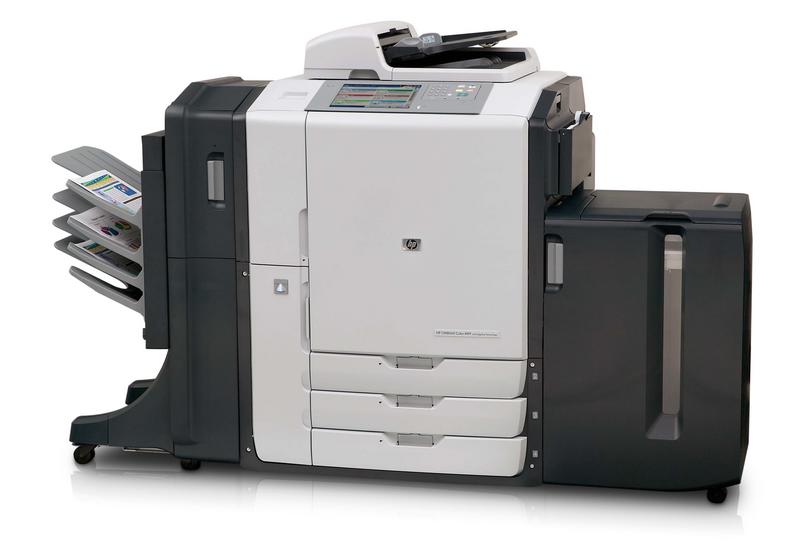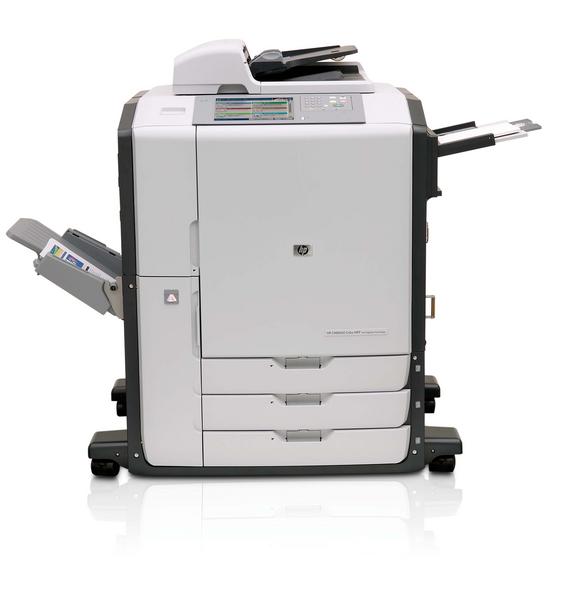EXCLUSIVE: HP CM8060 Edgeline Printer review
Top output quality, very low running costs and a quite remarkable level of features
Lasers beware as HP introduces a new high-speed inkjet printing technology. Print speeds are below par but the CM8060 delivers top output quality, very low running costs and a quite remarkable level of features.



Medium sized business and enterprises looking for top colour and mono print speeds plus multi-function capabilities have traditionally had no option but to go for a laser printer. With its new Edgeline technology, HP has turned this notion on its head as its latest CM8000 family delivers up to 60ppm mono and 50ppm colour but are essentially inkjet printers.
The new printers target businesses with a real appetite for paper as they aim to satisfy a monthly volume of 25,000 to 50,000 pages. They're pitched against colour copiers from the likes of Xerox, Canon and Konica and although they provide support for A3 printing are optimized for A4 operations with the bulk of printing comprising text and business graphics with around 40 per cent colour output.
Clearly, standard inkjet technology is totally unsuited to high-volume printing for a number of obvious reasons and Edgeline aims to solve them all. It's been seven years in the making and uses four, water resistant, pigment-based inks which HP claims offers superior contrast and brighter colours to dye-based inks. The biggest problem HP needed to tackle was drying time otherwise you'll end up with a soggy mess in your output tray at these speeds. The printer uses a unique bonding agent which is delivered by a pair of dedicated print heads. The agent is applied first where it grabs the ink and pulls it into the paper and a blower is used for final drying.
The next problem is keeping the print head nozzles clean and the printer uses a series of lasers to measure the droplet sizes. If the droplet gets smaller it indicates that the nozzle is getting blocked so the printer 'spits' ink though the problem nozzle to clear it. Paper is introduced to the print head array by placing it on a large rotating drum which uses a vacuum to hold it in place and is large enough to accommodate three sheets at a time. To stop ink 'spits' ending up on a page the drum has slots between each paper position and cleaning only occurs when these are level with the relevant print head.
The printer is very simple to operate and we found build quality to be exemplary. Opening the side panel reveals the drum with the print heads located above and fitted to assemblies that can be pulled out for easy access. However, the print heads are not consumables and are designed to last the life of the printer. The ink cartridges are located below and are very easy to remove and replace. Printing costs are a little difficult to estimate as the printers are purchased with yearly maintenance contracts which include replacement ink. However, HP claims 30 per cent lower running costs than equivalent toner based lasers with costs of between 2.5p to 4p per colour page.
One feature we really like is the new operator control panel. The print formatter runs XP Embedded allowing HP to provide a higher level of access via a large 10in. touch panel. The menu system is very intuitive and HP had added video clips to show users how to clear paper jams and replace consumables. This ties in with a feature coined 'digital breadcrumbs' where each accessible component has an LED on it. If a jam occurs the panel runs a step by step video and uses the LEDs to show the user where to go. There's also less risk of injury as the printer's blower runs at 30C which is a lot less than a laser fuser unit.
Combine the operator panel with the options available in the bundled drivers and users have a lot of features to play with. From the printer you can access functions such as copying, scan to email, network folder or the internal hard disk and display a job status. The scan function supports a wide range of formats including PDF, JPEG and TIFF whilst OCR comes as standard. This is provided by ReadIris Pro which is installed on the embedded XP and can output to HTML, CSV and XML. From the driver you can select the professional colour mode but the general office mode aims to deliver draft copies that reduce costs by around 30 per cent and are good enough to used as final copies. We compared draft prints from the usual suspects with those from the CM8060 and they are, indeed, much better quality.
During performance testing we found HP's quoted speeds to be somewhat optimistic although speed really will depend on the type of document as pages may require more than one pass. A basic 100-page Word text document was delivered in 143 seconds for an average of 42ppm. Our 120-page DTP test document with its collection of colour graphics and photographs dropped into the output bin in 237 seconds in professional mode and 209 seconds in general mode for speeds of 30.5ppm and 34.5ppm respectively.
The CM8060 may not impress in the speed stakes but it really scores for print quality. Text is razor sharp even down to the smallest font sizes whilst mono photographs also show very good levels of detail. Charts and graphs in our test reports were cleanly produced and colour blocks laid down with no white edging showing placement to be very accurate. The printer isn't aimed at photographic use and we did find that colour pictures lacked a certain vibrancy. However, the characteristic banding often found with many high speed lasers is virtually non-existent for the professional mode. As with mono pictures we also found the printer was capable of resolving a lot of detail in darker areas of colour photographs. With our performance test we could see colour fades with almost no stepping at all and grey shades using different mixes of cyan, magenta and yellow were reproduced faithfully with no colour casts evident.
The CM8060 delivers an innovative colour inkjet technology that looks a very solid alternative to high volume lasers. We couldn't achieve the quoted speeds during testing but quality is undeniably good and the printer design and operator panel makes it extremely user friendly.
Verdict
Lasers beware as HP introduces a new high-speed inkjet printing technology. Print speeds are below par but the CM8060 delivers top output quality, very low running costs and a quite remarkable level of features.
600 x 600dpi A3 colour inkjet Up to 60/50ppm A4 mono/colour 1.6GHz Intel Pentium M-730 1GB DDR2 SDRAM 2 x USB 2.0 2 x EIO slots JetDirect Fast Ethernet print server 80GB hard disk 600 x 600dpi colour copier 3 x 500-sheet input trays 100-sheet ADF tray 80-sheet bypass tray Drivers for Windows 2000 onwards, Linux and Mac OS
Get the ITPro daily newsletter
Sign up today and you will receive a free copy of our Future Focus 2025 report - the leading guidance on AI, cybersecurity and other IT challenges as per 700+ senior executives
Dave is an IT consultant and freelance journalist specialising in hands-on reviews of computer networking products covering all market sectors from small businesses to enterprises. Founder of Binary Testing Ltd – the UK’s premier independent network testing laboratory - Dave has over 45 years of experience in the IT industry.
Dave has produced many thousands of in-depth business networking product reviews from his lab which have been reproduced globally. Writing for ITPro and its sister title, PC Pro, he covers all areas of business IT infrastructure, including servers, storage, network security, data protection, cloud, infrastructure and services.
-
 Westcon-Comstor and Vectra AI launch brace of new channel initiatives
Westcon-Comstor and Vectra AI launch brace of new channel initiativesNews Westcon-Comstor and Vectra AI have announced the launch of two new channel growth initiatives focused on the managed security service provider (MSSP) space and AWS Marketplace.
By Daniel Todd Published
-
 Third time lucky? Microsoft finally begins roll-out of controversial Recall feature
Third time lucky? Microsoft finally begins roll-out of controversial Recall featureNews The Windows Recall feature has been plagued by setbacks and backlash from security professionals
By Emma Woollacott Published
-
 The UK government wants quantum technology out of the lab and in the hands of enterprises
The UK government wants quantum technology out of the lab and in the hands of enterprisesNews The UK government has unveiled plans to invest £121 million in quantum computing projects in an effort to drive real-world applications and adoption rates.
By Emma Woollacott Published